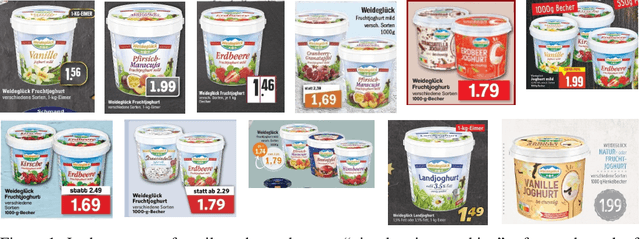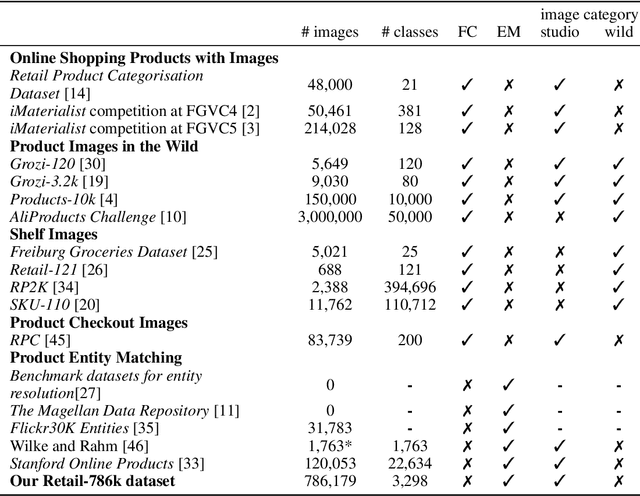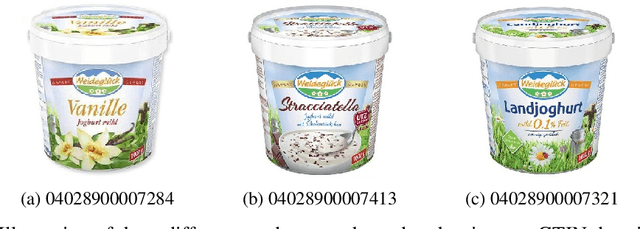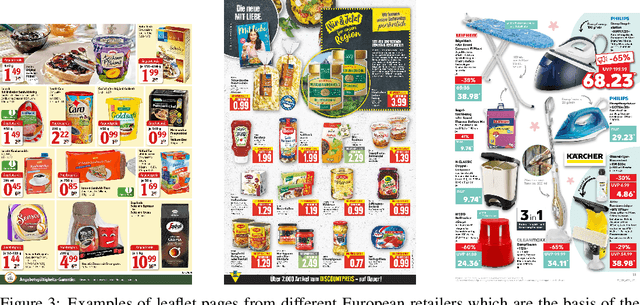Bianca Lamm
IMLA, Offenburg University, Markant Services International GmbH
A Visual RAG Pipeline for Few-Shot Fine-Grained Product Classification
Apr 16, 2025Abstract:Despite the rapid evolution of learning and computer vision algorithms, Fine-Grained Classification (FGC) still poses an open problem in many practically relevant applications. In the retail domain, for example, the identification of fast changing and visually highly similar products and their properties are key to automated price-monitoring and product recommendation. This paper presents a novel Visual RAG pipeline that combines the Retrieval Augmented Generation (RAG) approach and Vision Language Models (VLMs) for few-shot FGC. This Visual RAG pipeline extracts product and promotion data in advertisement leaflets from various retailers and simultaneously predicts fine-grained product ids along with price and discount information. Compared to previous approaches, the key characteristic of the Visual RAG pipeline is that it allows the prediction of novel products without re-training, simply by adding a few class samples to the RAG database. Comparing several VLM back-ends like GPT-4o [23], GPT-4o-mini [24], and Gemini 2.0 Flash [10], our approach achieves 86.8% accuracy on a diverse dataset.
Can Visual Language Models Replace OCR-Based Visual Question Answering Pipelines in Production? A Case Study in Retail
Aug 28, 2024Abstract:Most production-level deployments for Visual Question Answering (VQA) tasks are still build as processing pipelines of independent steps including image pre-processing, object- and text detection, Optical Character Recognition (OCR) and (mostly supervised) object classification. However, the recent advances in vision Foundation Models [25] and Vision Language Models (VLMs) [23] raise the question if these custom trained, multi-step approaches can be replaced with pre-trained, single-step VLMs. This paper analyzes the performance and limits of various VLMs in the context of VQA and OCR [5, 9, 12] tasks in a production-level scenario. Using data from the Retail-786k [10] dataset, we investigate the capabilities of pre-trained VLMs to answer detailed questions about advertised products in images. Our study includes two commercial models, GPT-4V [16] and GPT-4o [17], as well as four open-source models: InternVL [5], LLaVA 1.5 [12], LLaVA-NeXT [13], and CogAgent [9]. Our initial results show, that there is in general no big performance gap between open-source and commercial models. However, we observe a strong task dependent variance in VLM performance: while most models are able to answer questions regarding the product brand and price with high accuracy, they completely fail at the same time to correctly identity the specific product name or discount. This indicates the problem of VLMs to solve fine-grained classification tasks as well to model the more abstract concept of discounts.
Are Vision Language Models Texture or Shape Biased and Can We Steer Them?
Mar 14, 2024



Abstract:Vision language models (VLMs) have drastically changed the computer vision model landscape in only a few years, opening an exciting array of new applications from zero-shot image classification, over to image captioning, and visual question answering. Unlike pure vision models, they offer an intuitive way to access visual content through language prompting. The wide applicability of such models encourages us to ask whether they also align with human vision - specifically, how far they adopt human-induced visual biases through multimodal fusion, or whether they simply inherit biases from pure vision models. One important visual bias is the texture vs. shape bias, or the dominance of local over global information. In this paper, we study this bias in a wide range of popular VLMs. Interestingly, we find that VLMs are often more shape-biased than their vision encoders, indicating that visual biases are modulated to some extent through text in multimodal models. If text does indeed influence visual biases, this suggests that we may be able to steer visual biases not just through visual input but also through language: a hypothesis that we confirm through extensive experiments. For instance, we are able to steer shape bias from as low as 49% to as high as 72% through prompting alone. For now, the strong human bias towards shape (96%) remains out of reach for all tested VLMs.
Retail-786k: a Large-Scale Dataset for Visual Entity Matching
Sep 29, 2023



Abstract:Entity Matching (EM) defines the task of learning to group objects by transferring semantic concepts from example groups (=entities) to unseen data. Despite the general availability of image data in the context of many EM-problems, most currently available EM-algorithms solely rely on (textual) meta data. In this paper, we introduce the first publicly available large-scale dataset for "visual entity matching", based on a production level use case in the retail domain. Using scanned advertisement leaflets, collected over several years from different European retailers, we provide a total of ~786k manually annotated, high resolution product images containing ~18k different individual retail products which are grouped into ~3k entities. The annotation of these product entities is based on a price comparison task, where each entity forms an equivalence class of comparable products. Following on a first baseline evaluation, we show that the proposed "visual entity matching" constitutes a novel learning problem which can not sufficiently be solved using standard image based classification and retrieval algorithms. Instead, novel approaches which allow to transfer example based visual equivalent classes to new data are needed to address the proposed problem. The aim of this paper is to provide a benchmark for such algorithms. Information about the dataset, evaluation code and download instructions are provided under https://www.retail-786k.org/.
Fine-Grained Product Classification on Leaflet Advertisements
May 05, 2023



Abstract:In this paper, we describe a first publicly available fine-grained product recognition dataset based on leaflet images. Using advertisement leaflets, collected over several years from different European retailers, we provide a total of 41.6k manually annotated product images in 832 classes. Further, we investigate three different approaches for this fine-grained product classification task, Classification by Image, by Text, as well as by Image and Text. The approach "Classification by Text" uses the text extracted directly from the leaflet product images. We show, that the combination of image and text as input improves the classification of visual difficult to distinguish products. The final model leads to an accuracy of 96.4% with a Top-3 score of 99.2%. We release our code at https://github.com/ladwigd/Leaflet-Product-Classification.
 Add to Chrome
Add to Chrome Add to Firefox
Add to Firefox Add to Edge
Add to Edge